Rockstar Games has scaled a mountain with Grand Theft Auto V, creating the best-looking, best-sounding and, most importantly, best-playing version of gaming’s most notorious franchise. Scaling one peak, however, reveals another — their cloud-piercing ambition to create a great ensemble video game drama, an epic of intersecting, interactive lives. Rockstar doesn’t summit that new peak as impressively with GTA V, but in its first attempt at such an audacious feat, makes a good go of it.
This is a game that feels like both the best of what anyone might expect from a GTA and the exciting, somewhat raw, uneven first try at a more interesting future for these kinds of massive open-world adventures.
This is a game that works both as apotheosis and rough draft.
But perhaps you’d simply like to know how it compares to GTA IV, the previous Grand Theft Auto released way back in the spring of 2008. Fine. This new one is far better-looking on console even though it is running on the same hardware, has a more interesting and varied world, has better average mission quality, is longer (possibly the same length if GTA IV‘s two episodic expansions are counted), is better-engineered, is less serious, but lacks a lead character as compelling as Niko Bellic. Also, V has planes. And tanks.
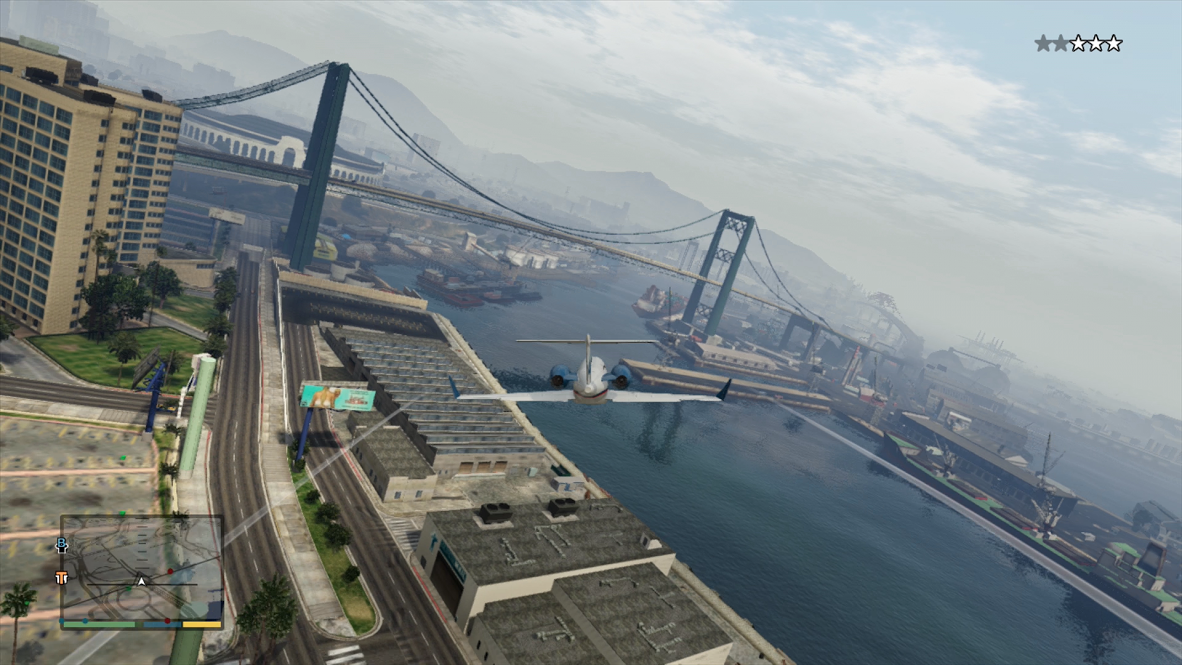
The Change
Like six of the previous seven Grand Theft Autos from Rockstar Games, GTA V is a third-person action game set in a massive three-dimensional world. This game’s world is a detailed, fictionalised recreation of Los Angeles and of archetypal nearby deserts, forests, mountains, lakes and small towns.
The game’s Los Santos is not real LA but a parody version, complete with parody radio stations, parody celebrities, and a parody Internet. A lot of it spoofs American politics and pop culture. Remember, this is the game series that has patriotic gun shops called Ammu-Nation. This is a GTA world stuffed with people who are mostly ridiculous. Almost everyone is a jerk and/or a joke. Almost everyone is a trope: dudebro financial guy, corrupt government agent, brainless starlet, mouth-breathing gamer, hardass lawyer. The game world is huge, varied, full of this kind of ridiculousness. It’s there to entertain you.
The most notable change to the series’ formula is that there are now three protagonists for the player to control. Instead of one ambitious Tommy Vercetti or one reluctant Niko Bellic, players of GTA V can switch back and forth to steer a trio of men through the congested Los Santos and the vast Blaine County to the north. They each have their own parts to play in their interwoven narrative.
The leads in the new game are all criminals but have very different lives. There’s Franklin Clinton, a black South Central native who has a crappy job at a car dealership and who dreams of pulling off some grand crimes. There’s Michael De Santa, a white supposedly-retired bank-robber living in the posh GTA version of Beverly Hills. He shares a home with a wife who is sleeping with the tennis instructor (and the yoga teacher), an annoying, talentless daughter who is trying to get on a TV talent show, and a lazy son who spends his days trashtalking his way through violent online video games and trolling celebrities on GTA V‘s version of Twitter. The third lead is Michael’s former bank heist partner, the balding white trash Trevor Phillips, now a meth dealer who lives up north in a trailer and who has a perforated line and the words “cut here” tattooed across his neck. The man is almost constantly screaming. He’s a psycho. Franklin, Michael and Trevor are drawn together and, soon enough, begin planning heists while also pursuing their own criminal ventures.
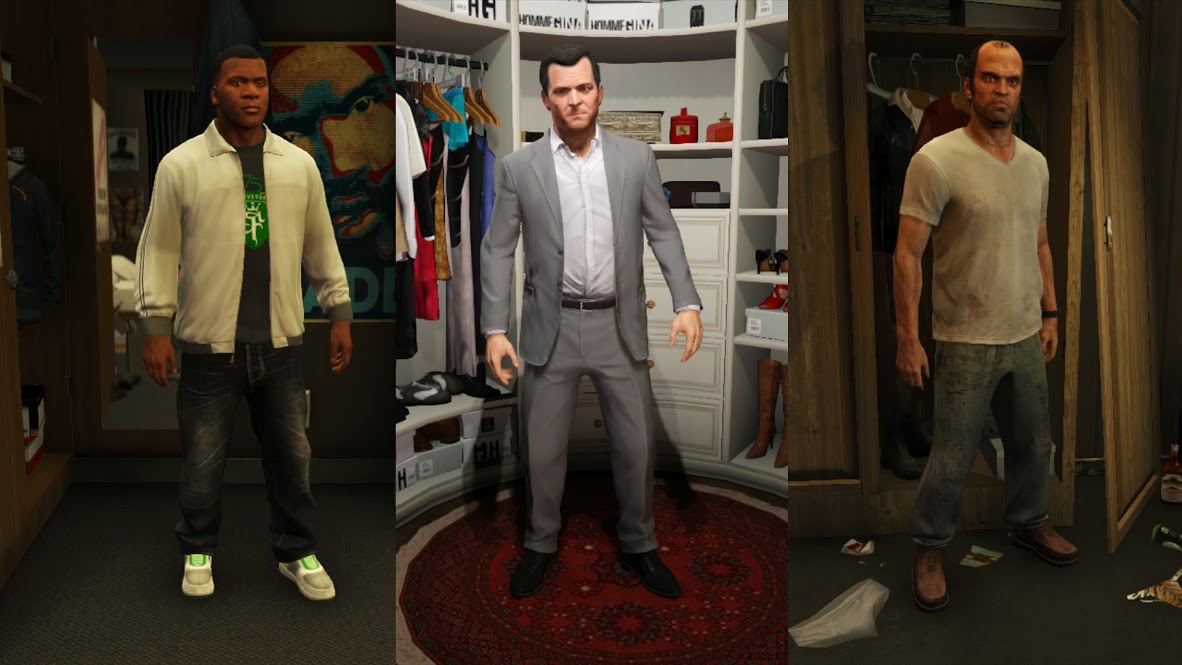
In the older Grand Theft Autos and in many of the games that copied Rockstar’s open-world formula, a player got around by running around or by making their character run up to any car or truck idling in traffic or parked on the side of the road and jack it. In the new game, there’s a third option. The player can hop across the map by changing characters and dropping into one of the other guys’ lives.
Once the game allows access to all three lead characters — and for much but not all of the rest of the game — the player can press a button on their controller to produce a circle that shows portraits of the game’s three leads. After one more input by the player to switch characters, the game’s camera will suddenly be reeled up into the sky, shift to another point above the GTA V‘s huge world and then push down onto the new character the player chose to control. These switches vary in length of time, but typically take fewer than 30 seconds. Michael, Franklin and Trevor don’t sit idle waiting to be controller. Whoever the player has switched to will appear to have been going about his day. A short scene will play out before the player has control. Judging by these transitional scenes, Trevor’s days seem to involve getting thrown out of places, tying men to the bottoms of piers, or stumbling around drunkenly while wearing only boots, socks and underwear. Michael’s and Franklin’s days are more like yours or mine (hopefully!).
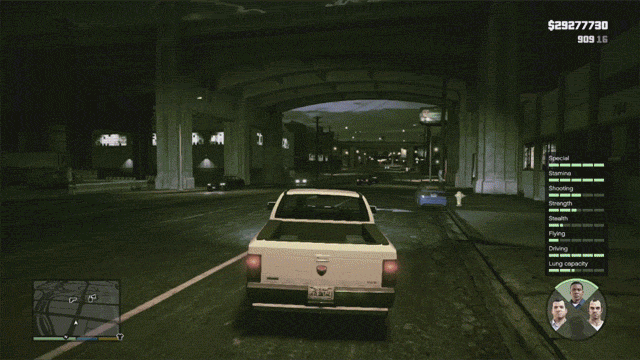
Players have no say as to where the character they’re switching to is hanging out in the world. The destination of the character switch is a surprise, which adds a welcome new variable to the GTA formula. Character-switching winds up being similar to flipping between three TV channels. You’ll know, in general, what you’re going to be tuning into, but you won’t know where they’re at in the show until you flip.
As before in GTA games, missions are sprinkled throughout the game world, Major missions — some 75 of them, despite what the in-game mission counter says — are represented by capital letters that are colour-coded to indicate which of the three main characters can initiate them. The new game’s pile of major sidequests — of which there are a few dozen — are also colour-coded. Some quest-givers have different missions for different characters and will weave in and out of each of the three leads’ threaded narratives. All of that enables GTA V to feel like the least linear game in the series, because even though it flows to certain bottleneck moments, it affords the player great liberty in choosing where to go, who to meet, what missions to go on — all with the randomised surprise of where on the map the player will be when they switch characters — to shake things up.
Once missions are triggered, the game narrows the player’s options by funnelling them into a carefully-planned sequence of cutscenes and tasks, similar to how other Grand Theft Autos have done it. But in this game, some missions will involve two or even three playable characters. Those missions will allow players to switch characters on the fly. In-mission the character switches are as quick as a finger-snap.
Some in-mission switches will be minor, involving, say, switching from Michael taking cover behind a car in a shootout with the cops to Trevor who is holding a sniper rifle while standing on a roof overlooking the firefight.
Other switches are spectacular, flipping, in one instance, from a character on a train that’s about to cross a bridge high above a river to a partner in crime in a boat on the river far below. The latter changes are often triggered automatically, but they nonetheless help the make missions feel more varied, less like a sequence of events and more like a juggle of multiple, simultaneous chaotic moments.
Regardless of all of that, players who plumb Grand Theft Auto‘s deep trove of missions, side missions, hobbies, mini-games, diversions, and random events will spend much of their time playing solo as whichever character they prefer. They’ll be doing what GTA players have long done: stealing a convertible, flipping radio stations, peeling down the highway, racing away from some pissed off cops and heading toward… a game of darts? A rampage? The military base where, this time, they’re going to steal a fighter jet?
The Numbers
Some GTA players ignore all the story missions and just play in the games’ chaotic sandbox. Others rush through the storyline. When I play open world games, I’m a wanderer and a checklist checker-offer. In advance of my review, I played Grand Theft Auto V for the better part of a week, taking my time to explore Los Santos and Blaine County instead of just driving from mission to mission. I’m a sucker for great scenery and interesting sidequests. The game is full of both.
A peer who mainlined the story and did few sidequests cleared the game in about 30 hours.
Another who was racing just from story mission to story mission was moving at faster than that rate.
I moseyed and didn’t even do the game’s first major heist until 11 hours into the game, didn’t unlock the third main character until after that and saw the credits roll, with 69 main quests done and 33 sidequests done in 42 hours. Fascinatingly, the time I spent as each of the three main characters was nearly identical:
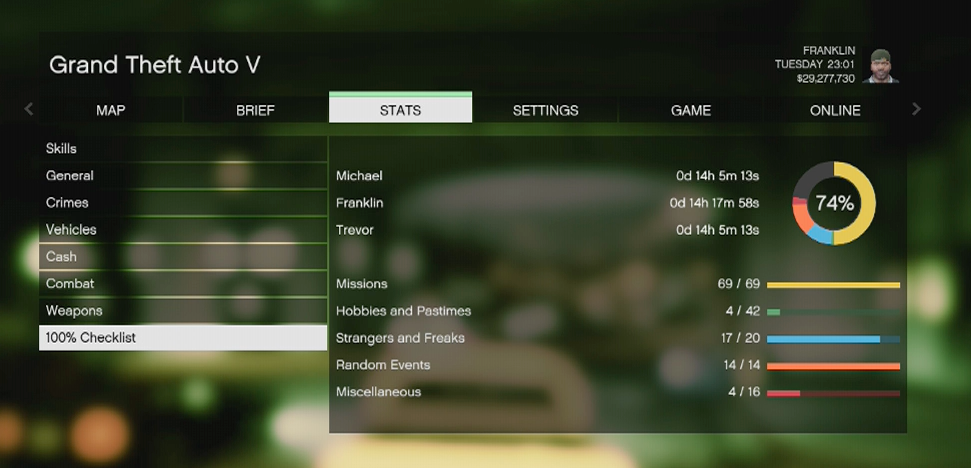
Playing the game this way let me take the story slowly and allowed me to poke around in sidequest after sidequest. The side missions opened more of the game up, triggering new special mission types like, say, base-jumping, while improving my understanding of the characters and enhancing the richness of the game’s world. Refrain from doing the sidequests and the game won’t just fail to send you parachuting, but it won’t take you to the peak of its highest mountain. Don’t do the sidequests and you won’t go jogging with a woman on the beach, you won’t be trying to steal celebrities’ belongings for an elderly demented British couple, you won’t see how Trevor deals with immigration issues, and you won’t see how, in a succession of three optional missions sprinkled throughout the game, each of the GTA V’s lead characters reacts to a man who is trying to legalise marijuana.
Even with the major side missions done, the game will only take you to Blaine County’s sprawling wind farm once, will never take you to its prison and will ignore the game’s stadiums and speedway. This is not a negative. Rather, it’s a testament to how immense and full of attractions GTA V‘s world is. Fly over the game’s spaghetti of roads and bridges and you’ll see that Rockstar has, graphically, ceased to operate in visual metaphor and instead has drawn with detailed realism a metropolis and its surroundings that are full of every kind of landmark and incidental element of real world terrain that you can think of: from fictionalised versions of the Hollywood sign, the Getty Center, the Rose Bowl, LAX airport and LA’s famous urban drainage canals, to trailer parks, ranches, quarries, shipping docks, diners, and some place where people paint rocks in the hopes of signalling aliens. Some of GTA V’s magnificent landscape may be there just for virtual sightseeing. Some of it may be used as a playground in the October-scheduled Grand Theft Auto Online, which, for starters, will use GTA V’s map (and is free for anyone who buys GTA V) .
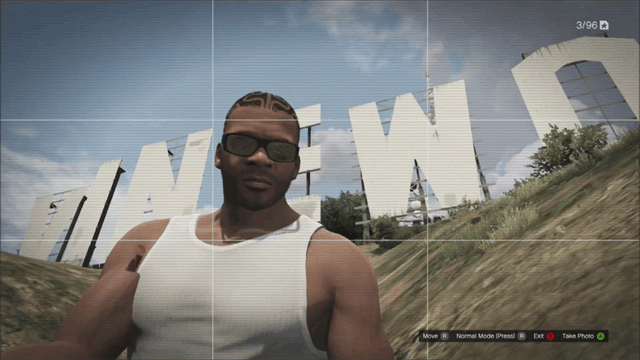
GTA V‘s lands and bodies of water also likely hold at least hundred secrets-specifically hidden collectibles of which I only found three in my 42 hours of playing. There is just so much in the game to explore, much of it trading off the appeal of real world geography. If the magnificence of a massive lake, the eeriness of an abandoned barn or the allure of biking up a big mountain does nothing for you, look for more fantastical game worlds to play.
The Four Games In a GTA
Vast as the game is, it can be boiled down into four elements. Every GTA, after all, is essentially four games happening at once. In no particular order, they are:
1) The Menu of Mini-Games: In a way, the cities of Grand Theft Auto games are glorified menus that grant access to smaller, more focused games. Want to play a game of darts? Or a video game version of yoga? Or tennis? Or golf? Or fly planes through targets? Or use said planes to drop things on targets? Or race cars? Race boats? Do a triathalon? Drive to the correct spot in GTA V and you can do that stuff. Versions of some of these activities have appeared in GTA games before; others are new. Games such as tennis are complex enough to stand as small games of their own.
For better or worse, though, these mini-games remain, for me, the least appealing part of the series. They are presented, more or less, dispassionately, without the snark and satire of the rest of the game’s world. They are, generally, exactly what you’d expect them to be. The darts game is just that, a darts game. There’s no flair, no imaginative gameplay twist, no buzz of that something special that makes a game or a game-within-a-game fun.
GTA V may have more mini-games than ever before, but these activities remain one-time tries for anyone but completionists, straight-faced diversions in a game world that otherwise seems to go out of its way to get a reaction out of you.
2) The Chemistry Set: GTA’s best element has always been its mad mutation of Pac-Man, its chase-or-be-chased action, set across what used to be a mostly-urban grid. The genius of 2001’s GTA III and its successors was their ability to give players an ever-flowing street-level version of this action and to give players an ever-increasing amount of freedom as to how they’d play it out. If you steal a car or shoot someone in these games, the police may well come after you. Whether you flee or fight back, you’ll deal with an intensifying response. The cops start driving toward you. If you’re on foot, you’re in for a gunfight. If you’re in a car, you’re in for a crazy chase. You’ll either get your character killed or manage to escape, but, usually, there will be a lot of chaos along the way. In GTA V, there are up to five “star” levels of notoriety, though when you’re down to zero there are actually relatively few cops around. Get to three or four stars and the police will send helicopters after you.
The big change to how GTA‘s central cops-and-robbers system flows involves how the cops chase you. If the police see you, the mini-map in the lower lefthand corner of the screen will flash blue and red, and the cops will be all over you. Give the cops the slip, and the mini-map reverts to black and grey, but little flashing dots representing the police will buzz through the mini-map, projecting a cone that represents each cop’s line of sight. What’s happening there is that the cops are hunting you down. You can’t stay stationary and hide. You have to move. You have to keep veering out of the line of sight until the police lose interest.
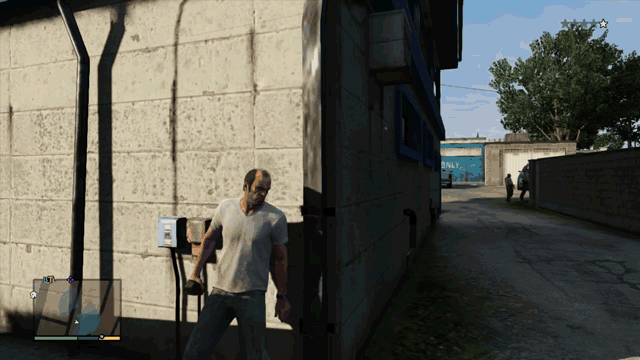
The police have always been the most interesting part of GTA‘s chemistry set, but there have been other elements mixed in, usually tied to specific vehicles. In the past, for example, stealing a taxi allowed players to start finding passengers and taking them to their requested destinations. That returns in V. In the past, other missions might spawn after stealing a tractor trailer or police car or delivery van or fire truck. Much of that appears to have been removed for V, though the wide range of vehicles to steal remains. If you’re stealing, say, a helicopter in this game, you’re largely just doing it for the fun of it.
GTA IV had added a cell phone to the mix and gave the player a lot of in-game friends who would call and ask to hang out. These friends were annoying. These people seemed to always want to go to bars or play pool or do any other of GTA IV‘s less fun activities. Each of the lead characters in GTA V has a cell phone and friends and family who call (or text or email), but they rarely ask you to do anything with them. You can go to the bar with them if you’d like, but only at your prompting.
So it’s not vehicles or friends that play a big role in tweaking the GTA chemistry set this time around. Instead, it’s money. The game runs on a much more complex economy than its predecessors and builds greatly on some property-ownership ideas introduced in Grand Theft Auto: San Andreas. In V, you can buy properties, take in weekly piles of money from those properties and even go on missions to keep that take high. Some of your property income will be affected by actions in the world. For example, the scrap yard yields a certain amount of money each week based on how many cars you’ve smashed in the game.
More interestingly, you can play the stock market. The game runs two stock markets, one controlled locally within the game and the other whose company stock prices are, according to Rockstar, determined by how the mass of GTA V players is all playing the game. Should, for example, one type of car get stolen a lot then the stock price of the auto-maker behind it will be affected. Stocks also change prices based on missions players are going on, so it behooves players to listen to their mission-givers and, perhaps, buy a ton of stock in the company whose rival CEO you’ve just been asked to assassinate.
GTA V‘s chemistry set is well-tuned for players to mess with. It’s tempting as ever to nudge an element here or there in it and see what happens as a result. You know, like… well, what would happen if I drove through the airport gate and tried to steal a private jet? What if I put all my money in Burger Shot stocks? What if I steal that fire truck? Go ahead and see what happens…
3) The Search For Stuff: It might be apostasy to purists of video game theory, but one of the most enjoyable things to do in GTA games, including this new one, is to find the next bit of non-interactive or barely-interactive content. GTA V is, in a sense, a massive treasure hunt. Like the franchise entries before it, it’s got a massive world that has all kinds of things in it that the developers would like you to find but aren’t going to make it easy for you to find. Well, not all of it’s easy to find. Some of what’s in the game is what series veterans would expect. You’ve got new in-game TV shows to watch. There are more than a dozen of radio stations to listen to, all with funny, satirical commercials. You can spend a few minutes in the game watching Rockstar’s send-up to nearly-incoherent foreign films.

The game’s fake Internet is bursting with websites that spoof major clothing brands, online dating services, self-help movements and more. None of this makes GTA V more interactive, but it helps make its world more interesting. It also makes the game a time capsule as the targets of its mockery — everyone from predatory lenders to people who camp out for iPhones, everything from skinny jeans to Google Maps — may not be around or be recognisable or may simply not be annoying in the same way by the time Rockstar makes another GTA.
A note about all this satire: it can be hard to take Rockstar’s skewering of modern (mostly American) culture all that seriously in a game that also offers interactive first-person lapdances as well as easy knocks at idiotic things like reality shows. Some might see the old Shakespearean gesture to both the highbrow and the lowbrow in GTA V‘s satirical abuse of tax-and-spend liberals and its jokey presentation of pot use. But GTA has done this stuff before, and its satirical newscasts — “Weazel News: Confirming Your Prejudices” — just don’t sting as much since they stung so many times before. GTA V finds its mark and makes a piercing point when it presents some of its satire in the game’s playable missions. Without spoiling it, one mission makes its point quite clearly about America’s post 9/11 treatment of people who look a certain way. By being interactive, it makes the player fascinatingly complicit in what it appears to criticise.
Most of GTA V‘s content hunt is actually not that heady. It’s also rarely dull. At turn after turn, there’s a new character to find or new place to visit, new thing to watch or listen to. For those who like to hunt and peck and peer at all corners of a game world, there’s much here to like.
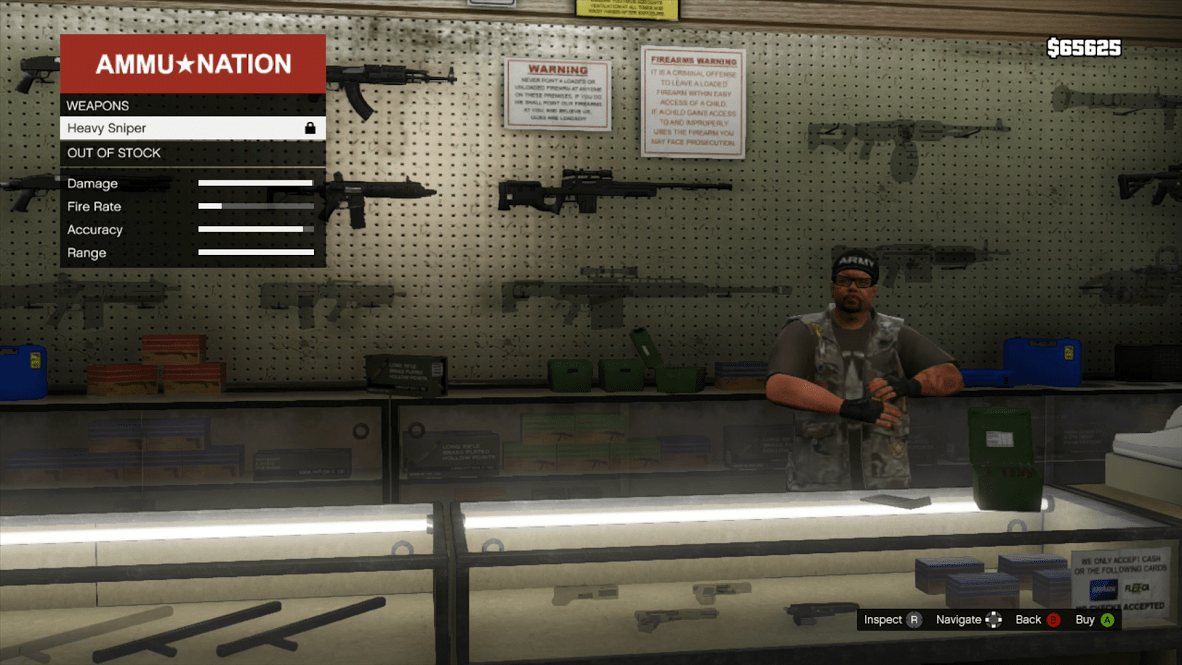
4) The Story. There’s a scripted adventure to be had in these games, one with a beginning middle and end. GTA V‘s got that, too. That’s where the ensemble comes in and that’s where the game ceases to be a perfecting of what has come before it in the franchise and more of an attempt, imperfectly, to do something new.
At its most basic, GTA V is a story about three men who come together to commit new crimes. Because they can’t be together at all times, the game’s writers and mission scripters needed to repeatedly find reasons to bring Michael, Trevor and Franklin together and then to split them up. While doing that, they needed to keep all three men interesting. Here, their success was mixed.
Separately, Trevor outshines Michael and Franklin. A complete nutjob who enters the game in a way that made him immediately incorrigible and fascinating, Trevor is the right kind of crazy for a GTA. His character fits his action, overcoming a flaw in previous GTAs that made the character that players controlled in the cutscenes (generally calm, bemused, and often reluctant men of action) feel wildly inconsistent with the one they controlled in gameplay (generally mass murderers willing to blow up dams, drive over pedestrians and machine-gun dozens of cops). Trevor is nuts in his gameplay. He’s nuts in his cutscenes. He also has weird relationships with his friends, is haunted by things that happened in his and Michael’s past and, overall, is someone who is interesting to control and find out more about.
Michael is, perhaps, half as interesting. His family dramas brim with potential but never achieve anything more than sitcom complexity. He’s in therapy, but that is played mostly for satire. Any epiphanies the character has feel unearned. He has his own issues with his past and he has potential as a mentor to Franklin, but aside from a dalliance with a possible career change at one point in the game, he feels paint-by-numbers and lacking in surprise or meaningful development.
Franklin is enriched by his friendship with Lamar, a hotheaded friend from South Central who steals scenes early and late in the game. Otherwise, though, Franklin is largely a blank, coming to life a little when exchanging emails with his ex-girlfriend but otherwise failing to distinguish himself as anything other than a mostly reasonable aspiring crook.
Many of Grand Theft Auto‘s previous protagonists were as blank or even more bereft of a memorable personality than Franklin, so it may seem unfair to knock two thirds of the leading cast. But the ensemble approach invites comparisons across that cast, and Michael and Franklin pay the price of the excellence of Trevor. Good supporting casts for all three leads at least help even things out. It’s one of GTA V‘s best touches that switching from one character to the next also feels like changing social circles. The problem is that Michael and Franklin, when sharing a scene with Trevor, lose out. He’s the one to keep your eyes on. And he’s the spark of most of the interesting exchanges between the characters. Trevor also follows Cole Phelps and John Marston, two exceptionally well-written, deep, interesting leads in Rockstar games. He ranks up there with them. His two buddies do not.
There are hints in the game of the storytelling power of having the player know more about what’s happening with all three characters than Michael, Trevor and Franklin do. Rare as that kind of thing is in games, Rockstar at least had previously played with the gulf between character knowledge and player knowledge to great success in its and Team Bondi’s 2011 L.A. Noire. For a stretch of the game, two characters have a very different understanding of something that happened in the past. The player knows the truth even as they control one of the characters who still believes a lie. There are few other examples like that in the game. But those parts of the story don’t quite feel fully realised; they’re glimpses of a fascinating new way to tell interactive stories, but their potential never feels sufficiently tapped.
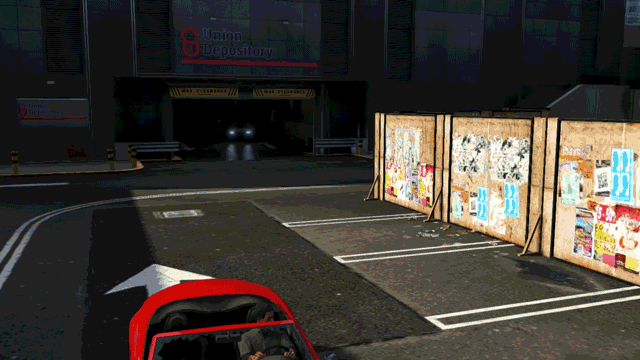
There’s something undeniably potent about experiencing a story as a variety of members of an ensemble cast. For all the multi-character role-playing games out there, the concept feels largely untapped. In the writing and the mechanics of giving GTA V‘s lead trio missions together, Rockstar’s new game feels like it is making progress, but not quite getting it, not quite justifying narratively why these guys would stick together, not quite getting the most out of what a player’s relationship to three different characters would be and, simply, not quite presenting as evenly excellent a lead cast of characters as it probably would have liked to.
Players may find themselves occasionally yearning for the simple, single arc of GTA IV‘s Niko Bellic, forgetting the dull parts in a narrative that was stretched too thin. Michael, Trevor and Franklin benefit from shorter tales but would have benefitted even more from more interesting arcs and intersections.
The Heists
Michael, Franklin and Trevor are brought together in GTA V to go on heists. While promoting the game, Rockstar officials described a handful of malleable heist missions that would see the lead characters coming together. These missions would give the player the opportunity to tweak some variables and play the heist differently from other gamers. These capital-H Heist missions do present some of the most exciting big-action moments of the game’s main storyline, but they’re, surprisingly, not the game’s best missions. They’re not even all of the game’s biggest missions.
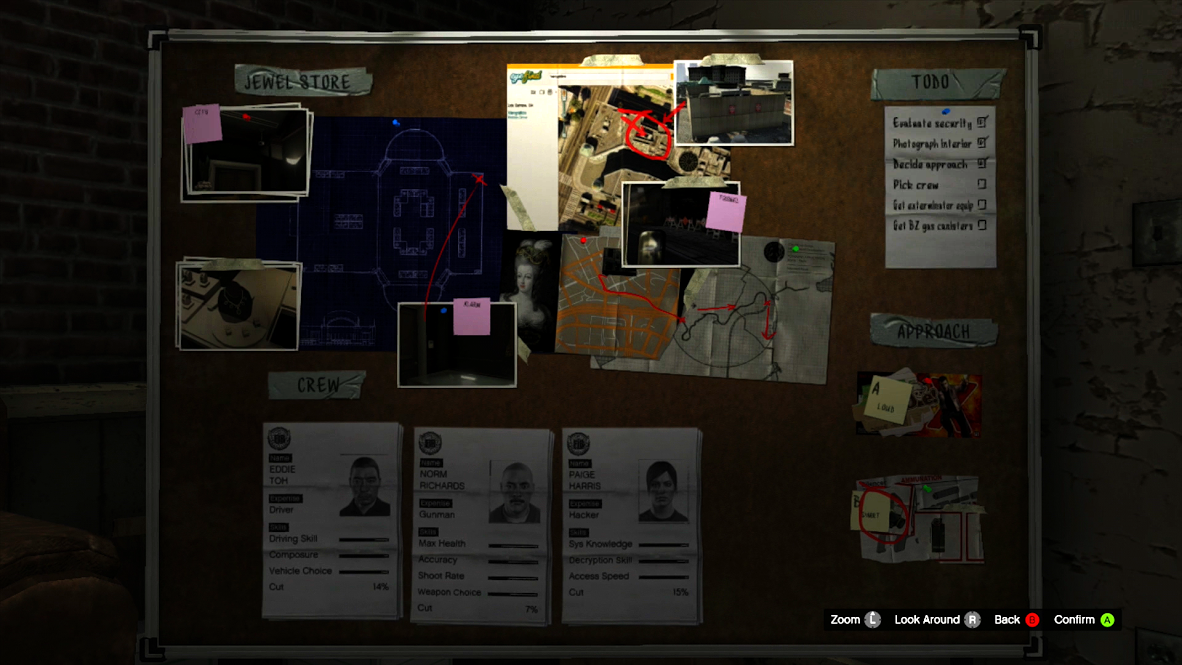
Something is off about the Heists. They may branch. They may be playable different, fun ways. But some of the choices and systems associated with them feel half-baked. The Heists present options, for example, about which henchmen to bring along. Some of these henchmen are found in the game world. They can serve roles as drivers or gunmen. The henchmen have varying skill levels and demand a different percentage of a heist’s haul. Really bad henchmen will screw up part of a heist. Good ones gain stat bonuses after finishing a heist. The problem is that nearly none of that seems to matter. The consequences of using these henchmen or of repeatedly using one in order to raise their stats are nearly invisible. It seems to matter little what their take is, because players make a decent amount of money in this game no matter what.
Perhaps these core specially-designated Heist missions should be seen as great bonding moments for Michael, Trevor and Franklin. Sometimes, they are. But non-heist missions provide good moments for these characters — and some excellent interactive robberies — of their own.
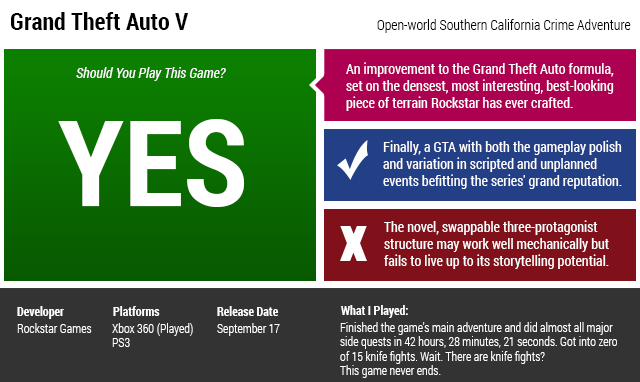
What It Feels Like
GTA V‘s credits roll for 36 minutes. For however many hours they play the game, players will feel that they are playing a game made by the amount of people it takes to keep a crawl rolling that long. The attention to detail in GTA V is likely unparalleled in any other video game.
Park a car and you’ll hear a few rattles as the engine cools.
Finish a mission as a man is ranting behind you and stick around… that rant just might go on for a while.
In comparing my experiences in some of GTA V‘s missions with others who’ve played them, we’ve discovered that one of us has heard lengthy in-game conversations that the other missed. It’s likely that players’ memories of the GTA V and understanding of the game’s events will vary because of this.
Thanks to the army of people who made the game, there is a generous amount of polish in the game and a lot of fixes that correct old GTA aggravations. A series once known in part for bad controls and unforgiving un-checkpointed missions now sports tight shooting, decent stealth and refined driving controls. Missions now checkpoint so much that players may start complaining the other way: that the game holds players’ hands too much. (Rockstar should be able to deflect that criticism, since each mission includes several gold-medal completion requirements that reward uncheckpointed, elite play.)
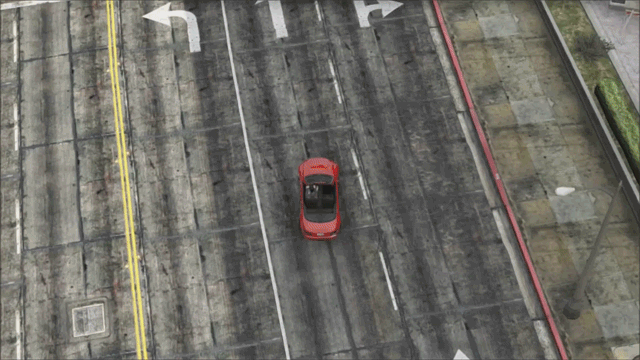
Another nice touch: each of the game’s three lead characters has stats associated with driving, shooting and other basic abilities that all improve with use. This helps makes controlling the game easier the more you play it. Early in the game, I kept retrying a race that was giving me fits. Each attempt didn’t just help me learn the game’s car physics; it made my driver, Franklin in this case, better at turning corners. Each character also has a metered special ability. Franklin’s ability, which slows down time while driving, makes hairpin turns during car chases a cinch and makes evading the cops more fun and less frustrating.
All of this makes GTA V feel more player-friendly than previous GTAs. This one wastes less of your time and forgives more of your small errors than any before it. It also just makes the experience of playing it more pleasant. Here’s a game that is well-resourced enough to dole out long conversations between your character and his passenger while driving, changes those conversations slightly (as IV did) if you’re repeating the mission, interrupts those conversations with some cursing from your passenger if you bump into traffic mid-conversation, and then picks up from that interruption to continue the scripted conversation without missing a beat. Incredible.
As Rockstar has made its GTA games the studio has gradually improved things like controls and checkpoints to get to where V is, but those improvements had seemed to come paired with a taming of GTA‘s possibilities. Older GTA games’ open-ended missions let players find creative solutions to accomplish various driving or assassination tasks. That approach gave way to missions in the likes of GTA IV that had fewer and, often, only one way to complete them. GTA V, thankfully, begins to turn against that. Some missions explicitly ask the player to plan an attack, supposedly any way the player would like to. Others simply offer an objective and leave it to the player to creatively figure out how to accomplish it. In a game so filled with scripted content, this is a welcome return to an earlier form.
It’s also impressive that GTA V seems to continuously find new ways to surprise its players by populating its world with small interactive events. The idea for the game’s semi-random encounters comes from the pedestrian missions in GTA IV that were expanded in Rockstar’s Red Dead Redemption. In both games, players would happen upon characters who had a few lines of speech and maybe a request to be transported somewhere or to have someone hunted down. GTA V is bursting with these kinds of things. Some, like the guy who is standing on his driveway looking at the clothes his enraged wife has thrown out of a window and who needs a ride out of there, seem tied to certain places on the map. Others, like the game’s numerous sidewalk robberies, seemingly happen anywhere. These small incidents are generally welcome — except the robberies, which are V‘s worst annoyance — and can lead to good things. A man needing a ride to the airport, for example, gave Franklin a great stock tip. Who knows what else is hiding in Los Santos.
By the end of GTA V, such as there is an end to GTA V, the player will have stories to tell. One is the story of Michael, Franklin and Trevor and follows the main plotline. That one’s ok. The better story to tell will be the one about all the things that happened at the margins… in the streets and alleys, off the airfields and down in the valleys. Much of that was written by Rockstar, too, and some of it was simply enabled by the marvellous chemistry-set of their game world.
Beyond all of this, however, is one consistent fact about so many of the best video games: they create great places in which to play. Underpinning everything else, in GTA V, Rockstar has created one of gaming’s most impressive worlds. They’ve built on geography that anyone who has visited LA or hiked a trail will recognise and appreciate.
Occasionally Grand Theft Auto V‘s main missions will push players up the map and out of the city, into the big-sky northern half of the game. In one such moment the player is controlling Trevor. He’s on a motorbike. He’s chasing a plane that is also heading north. Blaine County stretches as far as the eye can see, a world of possibilities. You can go to all those places you can see. You can do stuff there, probably cause some mayhem or go on a mission or just explore. It’ll look good when you get there, too. Mount Chiliad looms in the distance.
That’s GTA V at its best — excelling at what you thought GTAs were supposed to do, while heading for the next impossibly high peak.
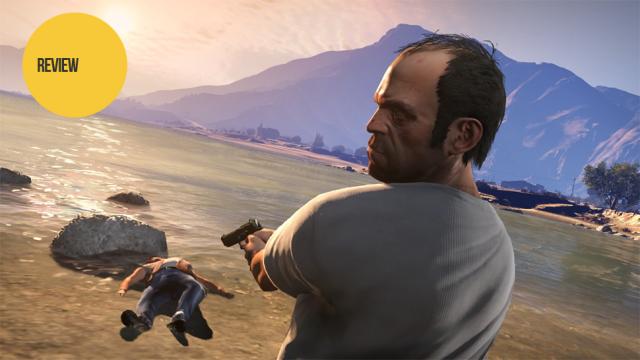
Comments
74 responses to “Grand Theft Auto V: The Kotaku Review”
Well, you cannot say that i didn’t try, i went to my local EB midnight launch only to have a security guard tell me that the line up was two and a half hours long and most probably wont receive my game until at least 2:30am that’s the first downer, second is the quality of life, seas of Adidas tracksuits and bum-bags everywhere. I do admit that i suffer social anxiety and i don’t do well in big crowds, i don’t freak out but given the choice i do avoid them, so having a choice i wussed out and went home disappointed i wont be playing GTA V tonight.
PS. i suppose the hoards of P plater Commodores should have told me that the gathered crowd won’t be the pinnacle of mankind.
For me, there was about 100 people in line, but since I had silver I skipped ahead to about 10th. In and out in 2 minutes.
Yeah, i’m level 3 as well but i doubt it would have done anything or made it any quicker, oh well i wussed out but i will go in first thing in the morning and pick it up, but i do have an unnatural fear that they will sell my copy.
I’m a level 4, once midnight hit we were the first ones to get our copies. Just about to finish installing. This is gonna be awesome.
You didn’t wuss out ‘Luke’, you made a smart decision. Leaving an area populated by Adidas and bumbags is a very sensible, rational choice. Stupid people do very stupid things, so you avoid them. I will be with you tomorrow morning getting the game at 9.00am and yelling at my local Dick Smith employee for not having blimp codes and charging me the wrong price!
I have similar issues with crowds and public places. I feel your pain bro.
Just buy it in the morning. Or buy a digital copy.
Is it available to download off PSN store or whatever it’s called. I’m a PC gamer that is dusting off the ole’ PS3 just for this game and I seriously cannot be bothered heading to EB Games “where the prices are inflated and so are the wait times”.
I haven’t bought a hard copy of a game for about a year. All direct downloads from Steam/Orgin/Ubisoft 🙂
The psn price in Australia is a rip off $109.95 for a digital download! Even EB has that price beat at $108 (best value I’ve seen is harvey norman for $88). How is a digital download more expensive than every single physical retailer?
Right, you expected people to turn up in suits and trendy clothes at midnight to pick up ONE GAME. I was one of the people wearing Adidas tracksuits and a “bum bag” but I can assure you I have a higher standard of living than you have.
People that wear Adidas and bum bags normally sit on trains and beat people up, so you should expect people will react like that. Plus, anyone that wears a bum bag should be discriminated against.
thats your own fault for going to an EB games to pay nearly $40 more then JB HiFI
Oh man, imagine people logging on to Kotaku while they wait for the installation right after midnight release, and to find out it got bad reviews 😛
Like that was ever going to happen
I like to remain optimistic that all reviewers aren’t bought out.
So I’m guessing you don’t head over to IGN or Gamespot much…? :p
I Pre-ordered on the PSN today, does anyone know when the actual game will unlock? Its half past launch and still nothing….
Thumbs up if you’re just killing time waiting for the install to finish…
Whatever. I’m still busy playing Cookie Clicker.
Wife went into labour a few hours before the midnight release, lol. Still up all night, reading every review. I am zen, wrapped in patience and understanding.
Think I might be a bit late to this party, eh?
Wow congrats 😀 something infinitely more important. Is it your first?
Certainly is! And, yes, much more important. Poor dear is just waiting patiently while I read Games articles and roam the hospital in search of cold drinks and deep fried food 😉
Man. 10 years ago my boy was born. Make sure youre in there when the bub arrives. Its something a parent never forgets 🙂
Absatively! I’ll be delirious with exhaustion, but I’ll be there! Wouldn’t miss it for the world 🙂
Gawdammit Now I have to noms you next time for being a good first time dad lol
Lol *bows*
Congrats Slyph, you sir deserve a medal – let yourself experience every emotion! and hang in there, a tough, yet very fulfilling time ahead.
Exact same thing happened to me for the God of War 3 release.
Mass effect 3 for me
It was awkward for me because I was surrounded by geeks with bad acne, smelly odour, having weird debates like about their theories about nuclear war and while their parents are waiting in the car while I was waiting in line for my copy. Lucky I had lvl 3 EB World card so I didn’t have to wait long. This is my 1st experience in a midnight launch so I don’t know this is normal.
Don’t fight it, you were the king geek, and these are your people now.
Moohoohoowahahaaaa!
My most recent midnight launch was for Halo 3: ODST. It was 20 people sitting around in the adjacent food court maintaining distance from each other while we waited for the EB to open their doors. A few of the attendees were parents with their children who were up way past their bedtime, a couple were obviously annoyed girlfriends wondering aloud constantly why their boyfriends dragged them to this. I think we all expected something more.
Prior to that, I had gone to Halo 3’s midnight launch after becoming hooked on the multiplayer beta. I think I was the only guy who dragged himself there for a regular edition of the game. Everyone else left with one of the collector’s editions. For awhile I regretted not buying the legendary spartan helmet edition, but I got over it. I bought the legendary edition of Reach, and now I have a dust magnet statue that my cat keeps bumping into and Jun’s sniper rifle hand keeps falling off.
36 minutes for credits? There better be an achievement for that :p
My CE is apparently in-transit with driver as of 6:15 am. Tonight I will feast on the juices of digital gaming glory. My wife thinks my excitment is hilarious. Fortunately she as another 3 seasons of Gossip Girl to watch.
I’m curious at how the game actually performs… It does look quite stunning, but I’ve seen plenty of stunning games on the PS3 and 360 begin to fall apart at the seams whenever you start getting into really heavy combat… There is honestly nothing worse than a good looking game start to run at 10-15 FPS.
To be honest, as great as the game is, it looks around the same as GTAIV. All those fantastic high quality screens we have been teased with are clearly the shots from the next gen versions that Rockstar is being tight lipped about.
No way man. It looks heaps better. Crisper. More detail. Less of that watercolor effect, etc. The game looks fantastic. Nice improvement over 4.
Well that review just solidifies what I already know. Is a shame about Stephen’s reaction to the story, but I’ll totally let it slide if the gameplay’s up to scratch. I’m dropping by JB on my way home from work today and diving right in. Day off tomorrow, too – I can’t wait.
The people in the conference I’m supposed to be looking after are being summarily ignored.
I too am a Stew
And bought my copy fom JB
And have tomorrow off to play it 🙂
Twins!
Yeah, went to my local EB and luckily only about 120 people. I got in and out within 45 mins… I had to get it then as I foolishly pre-ordered the Special Edition at the place farthest from my work and wouldn’t be able to pick it up before the weekend. Screw that I say… screw that.
How long before the latest shooting in America is linked to GTAV and video games?
There was no way in hell I was joining the mouth breathers at EB last night for this launch. Strolled into my local Target at 11:50 and was out the door by 12:05 $79 lighter. Good times!
I’m surprised GTA5 doesn’t have any playable characters who aren’t straight dudes. Surely it’s time to have a bit of equality when it comes to creating mayhem.
Why the hell does it matter? I’m all for equality in every aspect (be it race, gender, sexuality) – but really? It’s pretty much a non-issue.
Still, there are 3 main characters and they’re all guys in GTA5. After 5 main games and all the spinoffs, there’s still no chance for anything different which could offer an interesting new perspective.
As stated by @dknigs – The Ballad of Gay Tony had a significant gay character. There was Bernie Crane and the Mayor who were openly gay. Previous instalments have also had gay characters. Each game is far different from the last, and I don’t see how sexuality would change anything. Like I said, it’s a non-issue.
Are you saying that one in every three American males is gay? No problem with Gay’s, but it’s not really a stretch to think that the three blokes in this story could easily be straight. They also made the Ballad of Gay Tony add on previously, so it’s not like Rockstar aren’t being inclusive.
No, I’m not saying that 1/3 USA Guys are gay – But I’m saying that after all of the GTA games and spinoffs, surely we could play as a someone different. One of the three main playable characters in GTA5 could’ve been a woman!
Not sure about the gay straight thing, but regarding no playable female characters, I always like to remember that the ratio of male to female serial killers is 10:1. So if a game focuses on killing and mayhem, I think a male lead is far more appropriate and believable. I’m sure it’s also because the target audience for this game is mostly male, which I don’t think would change much if they included female characters, simple due to the violent nature of the game. (Yes I’m saying that women generally prefer less violent entertainment).
Will it be possible to make a female avatar when GTA Online ships?
Yeh I agree with you… but then GTA (and most games) are about living the unlivable.. doing the undoable.. and so on… so having that 1 in 10 female antagonist is what games are about, mostly.. at least games like GTA.. 🙂
Most GTA games are catering mainly to a fairly low denominator kind of person… don’t go expecting anything intelligent in these games. It would be like complaining about Call of duty.
The funny part is that there are now playable female soldiers in the upcoming Call of Duty.
So, not being a hater here, but one thing I’ve noticed already: the feel of the motorbike control just sucks. It’s more akin to they way they handled in Saints Row 2. They were perfectly fine in IV, in fact, i used to quench my thirst for road rash by hoping a bike in IV, but this time around, yeah, they’re not great. That said, having a good time with the game thus far. Already witnessed a couple of distinct nods to the previous SA already… 🙂
I don’t understand how you’re meant to get a wheelie to count as a wheelie. I’ve done one down a massive avenue on the Ducati Monster wannabe and it still says my longest is 0.
Same. Been trying to do it using the same method I’ve done in previous GTAs, but I’m still reading zero too. I wonder if it’s glitchy. I mean, I had my first thunderstorm in-game last night that utterly poured and thundered, yet, there wasn’t a cloud in the sunny blue sky at the time.
I know in older GTA’s it didn’t count if you hit did too high a wheelie and the back of the bike scraped, but I was pulling pretty great round the middle wheelies.
I fell asleep at 11pm, didn’t set my alarm for midnight. Woke up at 12:45 and wondered if my EB would still be open. Rocked up, 3 people in line, price matched to Target’s $79 and was back home by 1:10am. Pretty smooth experience 🙂
Did anyone noticed the rating of this game is only R18-Drug use?!
Gawker Media is the 12 year old kid who has just discovered gifs, and feels compelled to use them *everywhere*.
This has to stop, I’ve seen it on a number of the sister sites – they aren’t fucking necessary. The one with the dude in front of the “Vinewood” sign? Why the hell is that even a gif? My head is full of fuck right now.
I’m with you on that one, Thrillhou! By the way, let me play your copy of Bonestorm.
Buy me Bonestorm or go to Hell!
I’ve always imported previous GTA’s for PS3 from the UK and never had an issue, on Ozgameshop though GTAV for 360 has a warning that you might need an EU account for DLC. Does anyone know if this should be an issue? I want more blood and hookers than is appropriate for an Australian audience.
1) I thought the game was uncut for Australia? I might be wrong though..
2) I was worried about this too, so I bought from MightyApe. $79 (with $4 shipping and the DLC blimp code)
3) It’s easy enough to have an EU / US PSN account, but not sure about credit cards and stuff, plus you have to sign up / in with a different address. Too annoying if you’ve bought heavily into the AU PSN thing.
Edit: Uh huh, uncut: http://www.gizmodo.com.au/2013/08/grand-theft-auto-officially-rated-r18-in-australia/
I’ll take the risk this time, plus I was too impatient so I just bought it for $78 from EB as I walked past lol. They’ve told us previous GTA’s were “uncut” in Aus before too, but comparing my UK copy of 4 with my friends local there is a hell of a lot more blood splatter before they’re deleted for re-draw in the UK version. I think the only one I don’t have uncut so far is San Andreas. I pre ordered GTA3 so still have the “recalled” RC version.
Just leaving this here for you brah, http://www.myfacewhen.net/uploads/3835-so-hardcore.jpg
Still not sure if I should get this game…can anyone tell me if GTA V has the same level of really appalling sexism that GTA IV has? I couldn’t play GTA IV past the few missions involving the puke-worthy cousin of Niko’s, can’t even remember his name. I know it’s parody, but the whole
“women are purely sex objects” theme in GTA IV was very bad taste.
Mine arrived via courier (from JB) at lunch time so I managed to install it and play the prologue during my break.
Game looks pretty damn nice, can’t wait to dig into it tonight.
I’ve submitted to the hype… I was going to wait for the PC release.. but I am getting the PS3 out of storage and playing this instead.
As my PS3 controller bit the dust some years ago (I’ve been making do with a PS2 dualshock ever since), I also decided to grab a brand new PS3 controller (I grabbed the Gold Metallic colour! bling bling!).. and since I was feeling generous (to myself), I grabbed the 426 page strategy guide as well.. more for the commemorative value than anything.. yeh.. a cool $200.. lol..
I did this exact thing (well, commandeered my xbox from wifelady), but I’ll drop it and leave it for dead if a PC version is released. I’m slumming it by having to using this damned awkward analogue stick to aim. Can’t believe people aim like this. I’ve been spoiled with mouse aiming for so long.
Kudos to Kotaku for not cynically deploying the “misogyny!!!!” tactic in order to boost pageviews. Unlike a certain other site.
Want pageviews? Throw the M-word around and watch the fallout radiate around the net
Im getting occasional frame drops…
anyone?
This game is amazing. I’ve spent countless hours just wondering around being engrossed in the game world.
By far the most detailed and immersive game world to date.
One minute you’re getting shot by cops in a high speed chase, the next you’re playing golf and then watching the sunset on a Ferris wheel.
The driving and shooting mechanics have been streamlined really well too.
It’s exactly what I wanted this game to be.
My first time playing a GTA game. I am surprised I never got into one before now after playing this for a couple of hours.
My first hour consisted of just driving around having a look about the map. At one point I saw a dirt road and headed down it. This road took up and down steep hills, over a dam wall and then back up a large hill. I decided to get out of my car and walk to the top of the hill for a look around. I was promptly killed by a mountain lion!
This was possibly the last thing I was expecting to happen. It is a game full of crazy encounters and unexpected moments. I am enjoying myself immensely.
I wonder if there’s an elf in the mountains. Because there’s a sign at a church that has the ‘s’ broken and it says that you should go ‘find out about your elf in the mountains’…